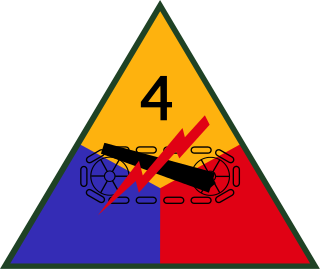
The 4th Armored Division was an armored division of the United States Army that earned distinction while spearheading General Patton's Third Army in the European theater of World War II.

The 6th Armored Division was an armored division of the United States Army during World War II. It was formed with a cadre from the 2nd Armored Division.

The General George S. Patton Memorial Museum, in Chiriaco Summit, California, is a museum erected in tribute to General George S. Patton on the site of the entrance of Camp Young, part of the Desert Training Center of World War II.
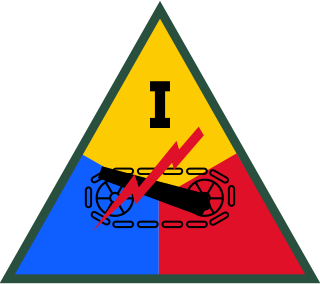
The I Armored Corps was a corps-sized formation of the United States Army that was active in World War II.

Rice Army Air Field is an abandoned World War II airfield in Rice Valley of the southern Mojave Desert, located 1-mile (1.6 km) east-southeast of the community of Rice. The airfield is located in Riverside County just south of the San Bernardino county line and State Route 62.
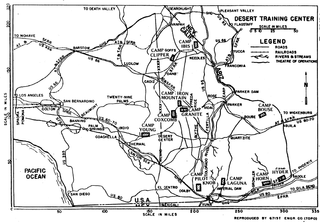
The Desert Training Center (DTC), also known as California–Arizona Maneuver Area (CAMA), was a World War II training facility established in the Mojave Desert and Sonoran Desert, largely in Southern California and Western Arizona in 1942.
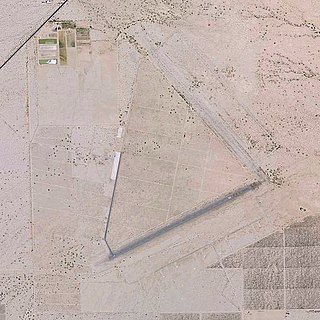
Desert Center Airport is a private-use airport located five nautical miles northeast of the central business district of Desert Center, in Riverside County, California, United States.

The Camp Granite was a sub camp of the US Army Desert Training Center in Riverside County, California. The main headquarters for the Desert Training Center was Camp Young. General Patton's 3rd Armored Division was stationed here. Camp Granite was designated a California Historic Landmark (No.985.2). The site of the Camp Granite is 45 miles East of Indio, California off Interstate 10 and California State Route 62 near the Granite Mountains.

The Camp Coxcomb was a sub camp of the US Army Desert Training Center in Riverside County, California. The main headquarters for the Desert Training Center was Camp Young where General Patton's 3rd Armored Division was stationed. Camp Coxcomb was designated a California Historic Landmark (No.985). The site of the Camp Granite is 45 miles East of Indio, California off Interstate 10 and California State Route 177 near the Coxcomb Mountains. The train stop at Freda railroad siding delivered Troops and equipment. The camp closed in early in 1944 after about two years of operations.

Camp Clipper and Camp Essex were subcamps of the US Army's Desert Training Center in San Bernardino County, California, located near Historic Route 66 and the Santa Fe Railway. The main headquarters for the Desert Training Center was Camp Young. This is where General George S. Patton's 3rd Armored Division was stationed. Camp Clipper was designated a California Historic Landmark (No.985.5). The site of Camp Essex is located near the Fenner Rest Area in Fenner, California, on Interstate 40 and Route 66, 32 miles (51 km) west of Needles in San Bernardino County, California, near the town of Essex. Currently at the south end of the Mojave National Preserve. Camp Clipper was just to the west of Camp Essex. Camp Essex was a temporary camp for incoming and outgoing troops. Camp Essex was named after a small town near the camp, Essex. Camp Clipper was named for its proximity to the Clipper Mountains. Between Camp Essex and Route 66 was the 4,500 foot Camp Essex Army Airfield.

The Camp Iron Mountain was a sub camp of the US Army Desert Training Center in Riverside County, California. The main headquarters for the Desert Training Center was Camp Young; this is where General Patton's 3rd Armored Division was stationed. Camp Iron Mountain was designated a California Historic Landmark (No.985.6). Camp Iron Mountain is near the site of Camp Granite, both are 45 miles (72 km) miles East of Indio, California off Interstate 10 and California State Route 62 near the Granite Mountains in San Bernardino County, California. In 1980 Camp Iron Mountain received the listing as an Area of Critical Environmental Concern from the Bureau of Land Management. The listing was given as Camp Iron Mountain is the best preserved of the Desert Training Center Camps. The Bureau of Land Management put up fences to protect the camp from Off-road vehicle traffic. Still at the camp today are a 200 x 175 foot contour training map, some rock mosaics, two church altars, rock lined roads and walkways. The camp is named after the near by Iron Mountains.

Camp Bouse was a secret camp of the US Army, Desert Training Center in Mohave County, Arizona. Camp Bouse is located 25 miles (40 km) from Bouse, Arizona, just north of Arizona State Route 72 and about 50 miles (80 km) north of Interstate 10.

Camp Hyder was a US Army installation in Arizona, functioning as a subcamp of the Desert Training Center in Riverside County, California. The main headquarters for the Desert Training Center was Camp Young, this is where General Patton's 3rd Armored Division was stationed. Camp Hyder is 2 miles (3.2 km) miles south of Hyder, Arizona. The camp was just north of the Gila River. Camp Hyder is 60 miles (97 km) miles east of Yuma, Arizona, near Camp Horn. Camp Hyder was built at the site of an old 1890s military base. Trained at Camp Hyder, in 1943, for six months was the 77th Infantry Division from April 1943 to September 1943. Then the 104th Infantry Division moved in for training. Unlike the other camps, no large tank activity was done. The camp was built by The 369th Engineer Regiment. Camp Hyder had its own rail station at which most troops arrived. The train station at Sentinel, Arizona south of the camp was also used. Over 13,000 troops were trained at Camp Horn and Camp Hyder.

The Camp Laguna was a sub camp of the US Army, Desert Training Center in Riverside County, California. The main headquarters for the Desert Training Center was Camp Young, this is where General Patton's 3rd Armored Division was stationed. Camp Laguna is 16 miles (26 km) miles northeast of Yuma, Arizona, off of U.S. Route 95. Trained at Camp Laguna were the 3rd Armored Divisions the 9th Armored Divisions, the 79th Infantry Divisions, 80th Infantry Divisions and 8th Infantry Division. The camp is named after the nearby town of Laguna, Yuma County, Arizona on the Colorado River. Camp Laguna was first World War II training camp built in the Sonoran Desert of Arizona, it trained thousands of troop for war. Most of the land that was Camp Laguna is now part of the vast Yuma Proving Ground.

The Camp Desert Center was a sub camp of the US Army, Desert Training Center in Riverside County, California. The main headquarters for the Desert Training Center was Camp Young, where General Patton's 3rd Armored Division was stationed. Camp Desert Center was at Desert Center, California, in Riverside County, California in the Colorado Desert.
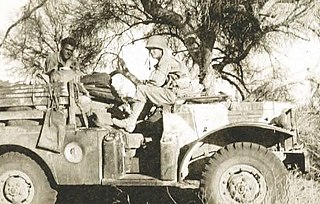
The Camp Horn was a sub camp of the US Army, Desert Training Center in Riverside County, California. The main headquarters for the Desert Training Center was Camp Young, this is where General Patton's 3rd Armored Division was stationed. Camp Horn was near Camp Hyder about 6 miles (9.7 km) miles west of Hyder, Arizona. Camp Horn was just north of the Gila River. Camp Horn was 54 miles (87 km) miles east of Yuma, Arizona. Most troop arrived at Camp Horn from the train station at Camp Hyder or the train station at Sentinel, Arizona south of the camp. Over 13,000 troops were trained at Camp Horn and Camp Hyder. The 81st Infantry Division trained at Camp Horn was from June 1943 to November 1943.

The Camp Pilot Knob was a sub camp of the US Army, Desert Training Center in Imperial County, California. The main headquarters for the Desert Training Center was Camp Young, this is where General Patton's 3rd Armored Division was stationed. Camp Pilot Knob was designated a California Historic Landmark (No.985). Camp Pilot Knob is near Felicity, California, in Imperial County, California. Camp Pilot Knob is 2 miles north of the US-Mexico border, just north of the now Interstate 8. The camp is five miles northwest of Yuma, Arizona and 2 miles west of the Colorado River. The camp was built just north of the Felicity train station, which was used to bring the troops and supplies to the camp. The camp is named after a hill south of the camp.
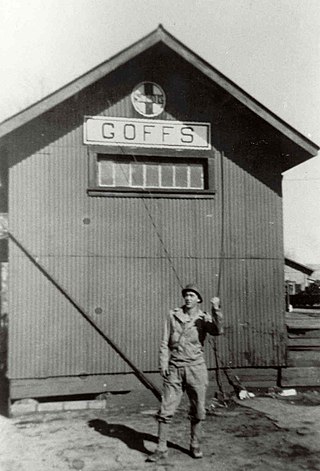
The Camp Goffs was a sub camp of the US Army Desert Training Center in Riverside County, California. The main headquarters for the Desert Training Center was Camp Young, this is where General Patton's 3rd Armored Division was stationed. Camp Goffs was designated a California Historic Landmark (No.985). The site of the Camp Goffs just north at the former Santa Fe Railroad station at Goffs, California. Goffs, California is on U.S. Route 66 5 miles north of the current Interstate 40, 25 miles (40 km) west of Needles in San Bernardino County, California. Currently at the south east end of the Mojave National Preserve. Camp Goffs was 20 miles southeast of Camp Essex and Camp Clipper.

California during World War II was a major contributor to the World War II effort. California's long Pacific Ocean coastline provided the support needed for the Pacific War. California also supported the war in Europe. After the Japanese attack on Pearl Harbor on December 7, 1941, most of California's manufacturing was shifted to the war effort. California became a major ship builder and aircraft manufacturer. Existing military installations were enlarged and many new ones were built. California trained many of the troops before their oversea deployment. Over 800,000 Californians served in the United States Armed Forces. California agriculture, ranches and farms were used to feed the troops around the world. California's long coastline also put the state in fear, as an attack on California seemed likely. California was used for the temporary and permanent internment camps for Japanese Americans. The population grew significantly, largely due to servicemen who were stationed at the new military bases/training facilities and the mass influx of workers from around the U.S. in the growing defense industries. With all the new economy activity, California was lifted out of the Great Depression. Over 500,000 people moved to California from other states to work in the growing economy. California expanded its oil and mineral production to keep up with the war demand.
Needles Station Hospital was US army Hospital built to support the training at the camps of the vast World War II Desert Training Center. Needles Station Hospital was located in the City of Needles, California in San Bernardino County, California. The main headquarters for the Desert Training Center was Camp Young where General Patton's 3rd Armored Division was stationed. Needles Station Hospital was on 875 acres of land and was open from 1942 to 1943. The hospital had two 250 bed hospital units. The hospital and camp was built using temporary buildings. Due to a shortage of manpower, Prisoner of War at the Hospital Camp volunteered to work at the hospital. The land was transferred back to the Department of the Interior on December 16, 1944. The site today is a mix of open land and housing. The Federal Property ID number is J09CA0507.


























